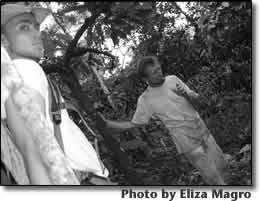
Inside the chocolate rainforest
by Chef Boy Ari

Ernst Gotsch walks through the Brazilian rainforest, machete in hand, preparing to intervene. "There is no necessity that I make an intervention," he says with a Swiss accent. "But if I do, the forest grows quicker." Then he hacks away a Brazil nut tree to make more room for the young jackfruit tree growing next to it.
Personally, I would have voted to hack the jackfruit tree instead. Jackfruit tastes like extra-sweet bubble gum - sickeningly sweet if you ask me. It's too bad I don't like jackfruit, because they grow to the size of watermelons and hang from the trees as thickly as apples. One thing is for sure: No matter how much you like jackfruit, you don't want to park your car beneath a jackfruit tree.
Ernst likes jackfruit but not as much as Brazil nuts. The reason he cut that particular tree is because there was a healthier specimen nearby, and there wasn't space for them both. So while the slower-growing Brazil nut grows into production, the faster-growing jackfruit will make a significant contribution to the agroforest system, as well yielding thousands of pounds of food.
More than any one particular plant, it's the whole system that Ernst cares about the most, including the weeds, which he considers the system's response to an imbalance. "Weeds do extremely well when the ecosystem is doing poorly," he says.
Then he said "Don't lean against that tree!" Without objection, I backed away from a spiky trunk crawling with fire ants.
Ernst owns more than 1,000 acres of land in the hills above the Atlantic Ocean in northeastern Brazil. He is a pioneer in the field of agroforestry. Exploiting the natural tendency of ecosystems to seek stability in biodiversity, agroforestry guides the growth of tailored forests, producing food for sale and personal consumption. In addition to being economically viable, successful agroforests are ecologically viable as well, providing habitat for animals and insects, harvesting the sun's rays rather than letting them bake the dry earth and stopping the wind before it blows away the soil.
Twenty years ago, Ernst's land couldn't have looked less like a forest. It was barren, sunbaked, stripped of its valuable timber, burned to the ground, and subjected to as many - or few - years of agriculture as the thin soil could support, at which point it was left for dead. Section by section, Ernst planted cocktails of mixed seeds and helped them grow with his interventions, cutting out the weak and old plants, making room for the vigorous. After 20 years of planting and intervening, his oldest pieces of land have blossomed into what I like to call the chocolate rainforest.
It's cool and peaceful inside the chocolate rainforest. Birds dart around the trees, which are heavy with fruit. Dominated by shade-tolerant cacao trees, whose seeds produce chocolate, the chocolate rainforest also contains bananas, avocados, citrus, mangos, papaya, tapioca, pineapple, Brazil nuts, jackfruit, palm trees, passion fruit and many others. It also contains inedible trees and shrubs whose purpose is to provide leaves and branches with which to mulch the bare ground, as well as other types of vegetation that some might consider weeds. Some of these so-called weeds have been shown to bring trace minerals to the surface from the depths of the soil. Some feed insects and animals whose excrement and dead bodies feed the soil. He treats all "weeds" as messengers from the ecosystem, telling him what it needs. Ernst then racks his brain for an edible species that could fulfill the same function.
Ernst hands me a football-shaped yellow fruit. It's the fruit of the cocoa plant, and I eat it by sucking the sweet white pulp from around the seeds as we walk past tarps full of cacao beans drying in the sun. When we arrive at his banana-drying apparatus, next to which freshly harvested bunches of bananas hang in the shade, Ernst says "Eat banana."
The creamy taste explodes in my mouth, joining the chocolate fruit pulp that coats my teeth. To round out the flavor equation, Ernst hands me a chocolate bean to munch on, at which point I was not suffering.
I'll leave you with a recipe given to me by Ernst's neighbor, Debora. It's a baked banana dish that my colleagues and I like to call "Sweet Banana Goodness."
Grease a baking pan with butter. Slice a bunch of bananas lengthwise into ½-inch strips and layer these strips in the baking pan. Put a little butter on top of each banana, and a little cheese (try cheddar or mozzarella). Then sprinkle cinnamon and brown sugar on top. Repeat for three layers of Sweet Banana Goodness. You can also add oats with each layer, and on top. Bake at 300 degrees for 20-30 minutes, or until the top starts to brown.
Next week, Chef Boy Ari's Brazilian adventure continues with a Brazilian version of something that is very close to his heart: mayonnaise! ☯
|